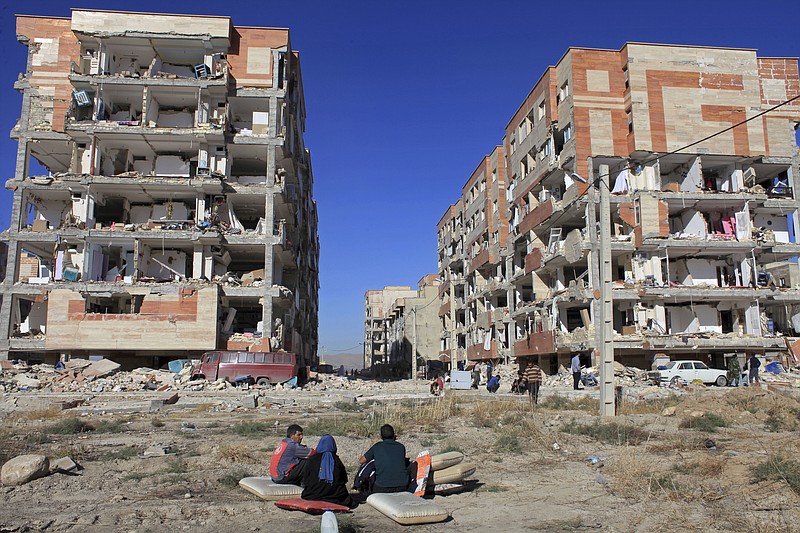TEHRAN, Iran (AP) — Rescuers dug with their bare hands Monday through the debris of buildings brought down by a powerful earthquake that killed more than 400 people in the once-contested mountainous border region between Iraq and Iran, with nearly all of the victims in an area rebuilt since the end of the ruinous 1980s war.
Sunday night’s magnitude 7.3 earthquake struck about 19 miles outside the eastern Iraqi city of Halabja, according to the most recent measurements from the U.S. Geological Survey. It hit at 9:48 p.m. Iran time, just as people were going to bed.
The worst damage appeared to be in the Kurdish town of Sarpol-e-Zahab in the western Iranian province of Kermanshah, which sits in the Zagros Mountains that divide Iran and Iraq.
Residents fled into the streets as the quake struck, without time to grab their possessions, as apartment complexes collapsed into rubble. Outside walls of some complexes were sheared off by the quake, power and water lines were severed, and telephone service was disrupted.
Residents dug frantically through wrecked buildings for survivors as they wailed. Firefighters from Tehran joined other rescuers in the desperate search, using dogs to inspect the rubble.
The hospital in Sarpol-e-Zahab was heavily damaged, and the army set up field hospitals, although many of the injured were moved to other cities, including Tehran.
It also damaged an army garrison and buildings in the border city and killed an unspecified number of soldiers, according to reports.
Iran’s Supreme Leader Ayatollah Ali Khamenei immediately dispatched all government and military forces to aid those affected.
Many of the heavily damaged complexes in Sarpol-e-Zahab were part of construction projects under former hard-line President Mahmoud Ahmadinejad. The newly homeless slept outside in cold, huddled around makeshift fires for warmth, wrapped in blankets — as were the dead.
The quake killed 407 people in Iran and injured 7,156 others, Iran’s crisis management headquarters spokesman Behnam Saeedi told state TV. Most of the injuries were minor, he said, with fewer than 1,000 still hospitalized.
The semi-official Tasnim news agency reported 445 dead and 7,370 injured. There was no immediate explanation of the discrepancy, although double-counting of victims is common during such disasters in Iran.
The official death toll came from provincial forensic authorities based on death certificates issued. Some reports said authorities have warned unauthorized burials without certification could mean the death toll was actually higher.
In Iraq, the earthquake killed at least seven people and injured 535 others, all in the country’s northern, semiautonomous Kurdish region, according to its Interior Ministry.
The disparity in the fatality figures immediately drew questions from Iranians, especially because so much of the town was new.
The earthquake struck 14.4 miles below the surface, a shallow depth that can have broader damage. Magnitude 7 earthquakes on their own are capable of widespread, heavy damage.
The quake caused Dubai’s skyscrapers to sway and could be felt 660 miles away on the Mediterranean coast. Nearly 120 aftershocks followed.
Kokab Fard, a 49-year-old housewife in Sarpol-e-Zahab, said she could only flee empty-handed when her apartment complex collapsed.
“Immediately after I managed to get out, the building collapsed,” Fard said. “I have no access to my belongings.”
Reza Mohammadi, 51, said he and his family ran into the alley following the first shock.
“I tried to get back to pick some stuff, but it totally collapsed in the second wave,” Mohammadi said.
Khamenei offered his condolences as President Hassan Rouhani’s office said Iran’s elected leader would tour the damaged areas Tuesday, which was declared a national day of mourning. Authorities also set up relief camps and hundreds lined up to donate blood in Tehran, though some on state TV complained about the slowness of aid coming.
Sarpol-e-Zahab fell to the Iraqi troops of dictator Saddam Hussein during his 1980 invasion of Iran, which sparked the eight-year war between the two countries that killed 1 million people. Though clawed back by Iran seven months later, the area remained a war zone that suffered through Saddam’s missile attacks and chemical weapons.
After the war, Iran began rebuilding the town. It also was part of Ahmadinejad’s low-income housing project, which aided the hard-liner’s populist credentials but also saw cheap construction.
Under the plan dubbed as Mehr or “kindness” in Farsi, some 2 million units were built in Iran, including hundreds in Sarpol-e Zahab. Many criticized the plan, warning the low-quality construction could lead to a disaster.
In Iraq, the quake shook buildings from Irbil to the capital of Baghdad, where people fled into the streets.
Iraqi seismologist Abdul-Karim Abdullah Taqi, who runs the earthquake monitoring group at the state-run Meteorological Department, said the main reason for the lower casualty figure in Iraq was the angle and direction of the fault line in this particular quake, as well as the nature of the Iraqi geological formations could better absorb the shocks.
University of Colorado geological scientist Roger Bilham said earthquakes in the Zagros range, where there are more than 20 different faults, have killed more than 100,000 people in the last 1,000 years.
Because there are so many earthquakes in the region, proper construction is critical, but it “doesn’t trickle down to the villages,” Bilham said.
Residents were clearing the rubble from the streets of Darbandikhan, about 6 miles from the Iranian border.
The quake caused visible damage to a dam at Darbandikhan that holds back the Diyala River.
“There are horizontal and vertical cracks on the road and in the body of the dam and parts of the dam sank lower,” said Rahman Hani, the director of the dam.

